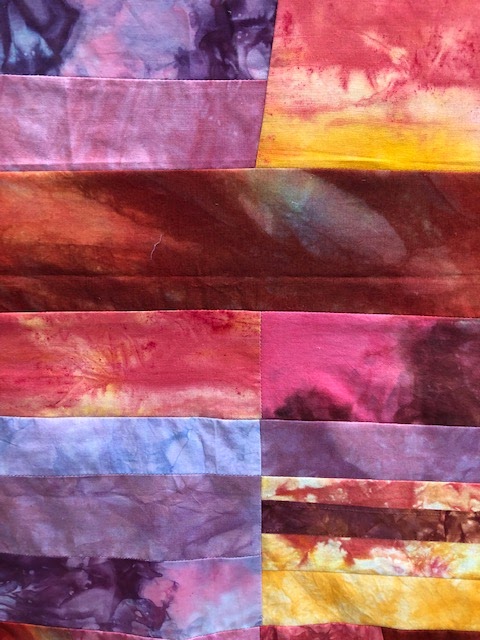Similar to the previous quilt Carpe Diem, this quilt starts out with the intention of bringing order out of chaos: from leftover strips of different lengths, widths and shades, and assorted small off-cuts lie scattered on the kitchen bench after the latest quilt top was completed. They are dancing before me, begging for attention to find a place of their own in connection and harmony with each other. As yet I don’t know how all these bits and pieces will come together. And I have a suspicion that there’ll be lots left over for the next creative exploration. Will it matter if they are randomly pieced and matched, simply by size and tone? I think not. So I get busy combining the strips into blocks, more like strips, without knowing the end result of size. And without realising that details were to come later.
As per usual, I break my own rules. Firstly by cutting pieces to fit evenly with another compatible colour tone. And by deciding to break the ‘golden rule’ of traditional piecing: to make joins meet at the points. It has a freeing effect in the process of creating my random patches of fabric, because as yet no clear design has been revealed, other than the earlier inspiration from Paul Klee. While I do attach perceived ‘finished’ patches or blocks to a design board, the usual process of pre-empting the final form, the concepts that have arisen during the process of making them are still in hiding. I’m not sure when they might appear, so it’s a case of working in the dark.
But of course suggestions for themes seep through, without imposition or insistence. Among them are those that arose during the making of the previous quilt, Carpe Diem. Themes, such as the four seasons and their cross-quarter mid-season days, those that signal the end of the previous season and herald the one that is on its way are very familiar. Then there are the daily changes that take us from morning, through to midday and on into the dark of night – also just simple reflections on the variants of weather changes, embedded in the realisation of climatic changes. There is no intention to impart scenic similarities (- though some I have seen are quite stunning, as the one below taken by a resident of Winmalee), but rather to evoke the experiences of seeing these seasons and times of day in the recollection of the viewer.
Like putting the pieces of a jigsaw together – or joining the various individual blocks that come together to form the final pattern in a traditional quilt, placement is important in the grand scheme of things. Eventually ideas for the final placements start to sneak in, make their presence felt as I am suddenly going into 'listening mode'. Instead of being locked into a jigsaw, or pattern, I can play with the pieces before deciding where they might be best placed. And it takes both seeing what is there, and listening to those suggestions from the fabrics. Still hovering in the background is the potentiality of themes to be presented: the four seasons, morning, noon and night, dawn and dusk... others might become more evident during the process of piecing.
The playfulness of creating is now being taken over by the materials themselves, though a conflict with the underlying concepts that have been hovering in the background seem to be emerging. And while I am not really willing to relinquish their offerings, they do seem to restrict choices - about placement in particular. I can and do acknowledge that the role of the artist is to make familiar things seem strange, this project and its process is not about splashing paint on a canvas and riding over it to see what results, a la Jackson Pollock – far too random a process and technique for my personality. There is after all a kind of ritual being observed in the creative process with fabrics, a narrative involving the construction of an emerging as yet to be revealed narrative.































